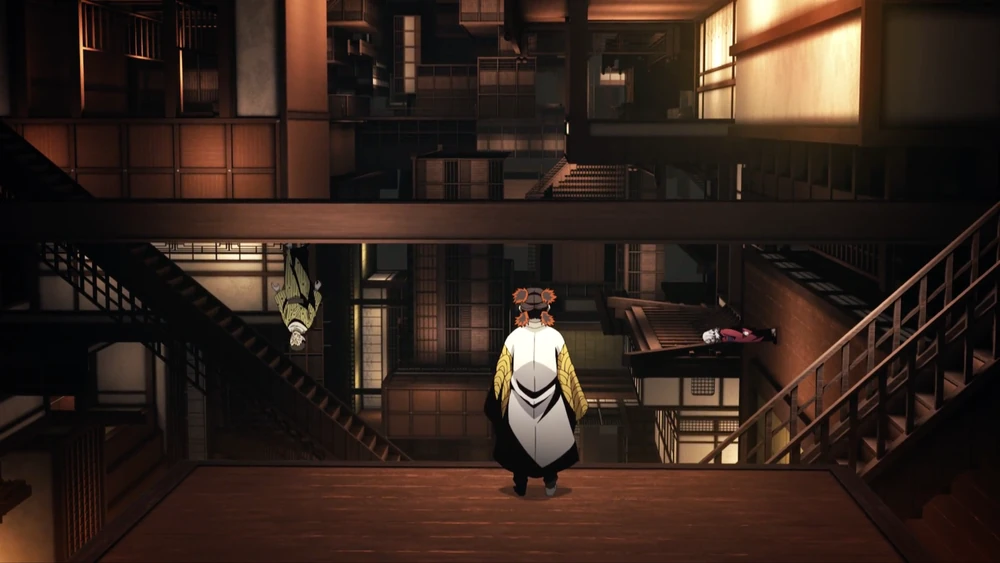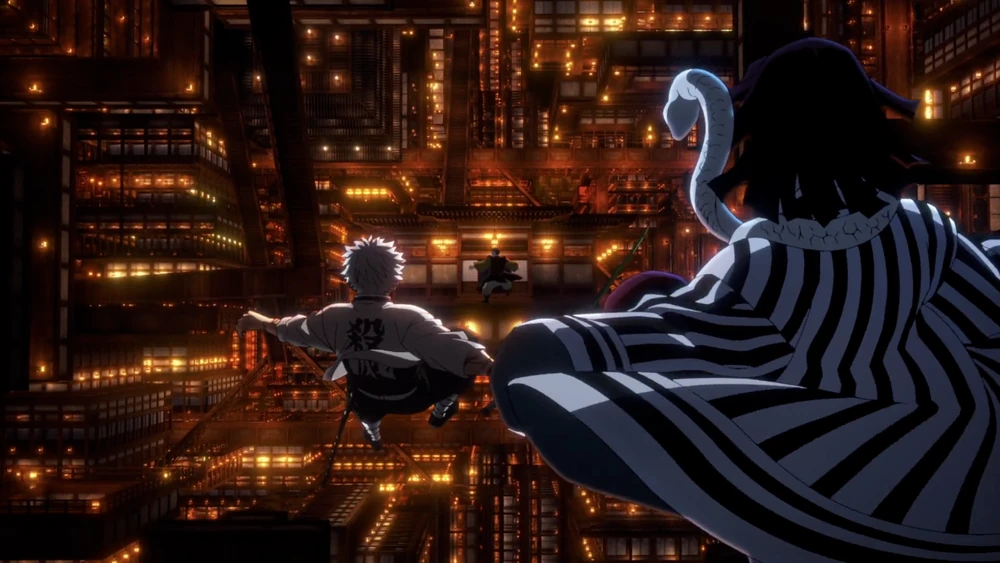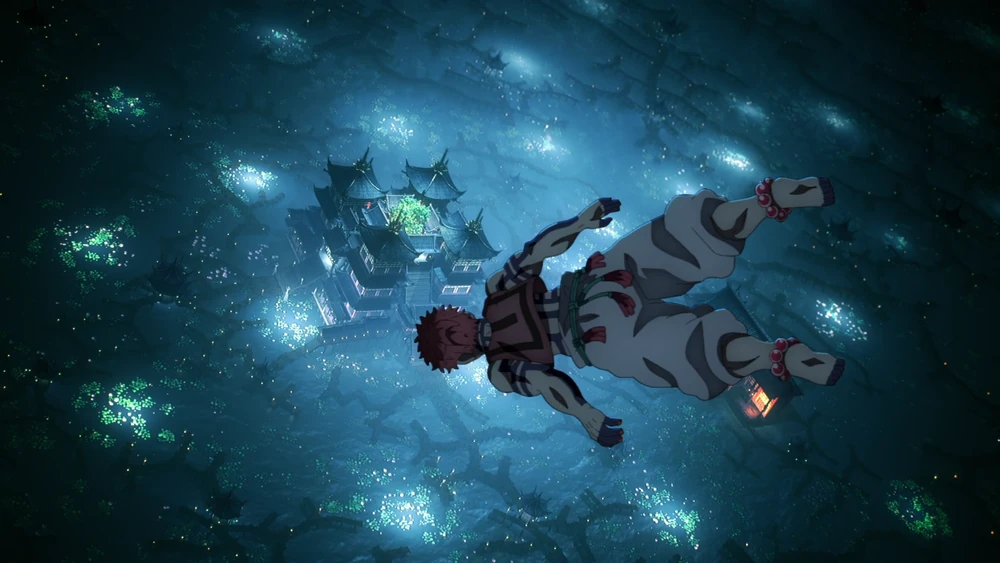In the world of Demon Slayer, evil is not just an action; it is an aesthetic. The series’ ultimate antagonist, Muzan Kibutsuji, commands his demonic forces not from a jagged throne of skulls, but from a space that is unsettling in its impossible beauty and psychological cruelty. The Infinity Castle—the Dimensional Infinity Fortress—is not merely a location; it is a physical manifestation of its master’s nihilistic philosophy and the most terrifying weapon in his arsenal.
By deconstructing the pivotal meetings held within its walls, we can analyze how the series masterfully uses background art to tell a story. The castle’s architecture is a tool of intimidation, a labyrinth of despair, and a reflection of a world where the individual will is rendered meaningless in the face of infinite, indifferent power.
Act I: The Power of Disorientation (The Lower Moon Meeting)

Our first introduction to the Infinity Castle is a masterclass in establishing dominance through psychological warfare. The Lower Rank demons are not summoned; they are abducted. With a single, discordant strum of a biwa, their individual realities are shattered, and they are violently transported into a bizarre, abstract non-place. The background art is an impossible intersection of wooden beams and paper screens with no clear entrance or exit, designed to disorient and terrify.
The direction reinforces this psychological attack. Muzan does not even deign to appear in his true form. Instead, he addresses them in his disguise as an elegant woman in a formal kimono, a chilling display of his contempt. He stands on a higher, separate platform, forcing the kneeling demons to look up at him in supplication. This physical elevation is a clear and brutal visual metaphor for his superior status. He is not just their leader; he is a being on an entirely different level.
Before he speaks a single word, the scene has communicated his core philosophy through the environment: You are in a place you cannot comprehend, and you are in the presence of a being you cannot reach. Your existence is subject to my judgment.
Act II: A Gathering of Titans (The Upper Moon Meeting)

When Muzan summons the Upper Moons after the death of Gyutaro, the scene is a stunning escalation of the themes from the first meeting. The demons are again transported with shocking suddenness, but the initial environment is bizarrely different. They are not in a traditional Japanese space, but a sterile, modern-looking laboratory, filled with beakers, tubes, and scientific equipment. And once again, Muzan is positioned upside down, looking down on them, reinforcing his absolute mastery over the physical laws of his domain.
This choice of setting is a profound insight into his character. While the castle’s exterior is an infinite maze of traditional Japanese architecture, Muzan’s personal workspace is a modern lab. This reveals his true nature: he is not a traditionalist or a mystic. He is a scientist, a pragmatist obsessed with a single goal—conquering the sun. He sees his own demons not as followers in a grand demonic tradition, but as tools and experiments in his personal scientific quest for perfection. The lab setting is a visual confirmation that he is utterly detached from them; they are merely subjects in his grand experiment.
Only after this initial, sterile confrontation does the camera pull back, revealing that this entire modern laboratory is just one small, isolated structure floating impossibly within the breathtaking, M.C. Escher-like cityscape of the true Infinity Castle. This reveal is a powerful statement. It tells the Upper Moons that their entire existence, their immense power, and even their direct interactions with him are just one tiny, insignificant part of a world that is infinitely larger and entirely his to command. They are not even in the “main” part of his world; they are in a side room, a laboratory, reinforcing their status as mere tools.
The Theater of Cruelty: A Tale of Two Loyalties

The most chilling demonstration of Muzan’s philosophy is revealed by comparing his treatment of the Lower and Upper Moons. In both meetings, he confronts failure, but his methods and the demons’ reactions reveal two profoundly different levels of control. The Infinity Castle serves as his personal theater for these lessons in power.
The meeting with the Lower Moons is a spectacle of corporate downsizing. After the death of Rui, Muzan mercilessly reads the thoughts of the remaining Lower Ranks. He doesn’t see subordinates; he sees flawed products. Their fear, their desire to flee, their excuses—he interprets all of it as weakness. His subsequent execution of them is a sterile, emotionless culling. The act is a clear and brutal message: you are disposable. Your individual life has zero value beyond your utility to me. Failure is not an option; it is a cause for termination. Their final thoughts are of pure, unadulterated terror.
In stark contrast is the meeting with the Upper Moons. When Gyokko (Upper Rank Five) appears, he is also fearful, yet his fear is twisted into a form of fanatical reverence. As Muzan’s hand touches his head, not to praise but to mutilate, Gyokko’s internal monologue is a shocking revelation. He isn’t thinking of the pain or the humiliation; his thoughts are, “He touched my head… Lord Muzan’s hand is on my head!” He experiences this act of brutal punishment as a moment of ecstatic, divine connection.
This is the core difference. Muzan knows a simple beheading is meaningless to a demon of this caliber. Instead, the mutilation is a calculated act of psychological conditioning. It is not just about reminding Gyokko of the hierarchy; it is about reinforcing a twisted form of love and devotion. The forced, instant regeneration is part of the performance. It demonstrates that their vaunted immortality is a gift he has given, and one he can make a mockery of at his whim. The culling of the Lower Moons was a lesson in disposability for those who feared him. The mutilation of Gyokko was a lesson in absolute subjugation for those who worship him, proving that in Muzan’s world, even agony can be framed as an act of compassion from their god.
The Labyrinth of Nihilism: The Castle’s True Meaning
The Infinity Castle is the ultimate symbol of Muzan’s nihilistic worldview. Its infinite length and depth, its endless stairs leading nowhere, its rooms that shift and reconfigure at the strum of a biwa—it is a physical manifestation of a universe without inherent meaning or purpose. It is a terrifyingly beautiful portrait of despair.
For a demon, there is no escape, no final goal, and no “top” to be reached. There is only an endless, meaningless existence of serving Muzan’s will within the ever-shifting prison of his power. The castle’s beauty is a cruel joke; it is a gilded cage of infinite size.


This is why pulling the Demon Slayers into the castle for the final arc is a strategic masterstroke. It is not just a change of venue; it is Muzan’s ultimate philosophical argument. He forces his enemies, who are defined by their unwavering purpose and human spirit, into a world that is architecturally designed to tell them that purpose is an illusion. The castle is a labyrinth built to break not just their bodies, but their will to fight. It is the ultimate home-field advantage, a place where the environment itself is the final boss, whispering to all who enter that their struggle is futile, and the maze is eternal.
All images are screenshots from their respective anime series or are in the public domain, and are used under Fair Use for the purpose of criticism and commentary. Sensei Square is an unofficial fan work and is not affiliated with the original copyright holders. © All rights reserved to their respective owners.

